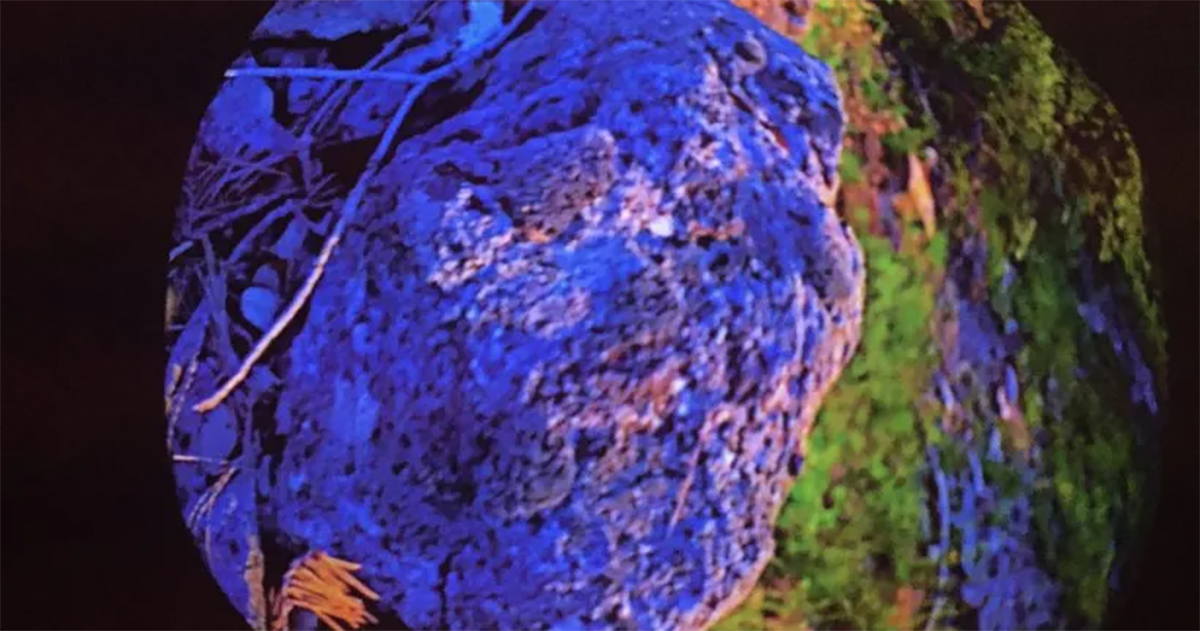
Virtual reality “is a lousy copy of our visual eye system,” contemporary visual artist Pipilotti Rist tells Louisiana Channel‘s Christian Lund in an interview recorded in winter 2019. Louisiana Channel is affiliated with Denmark’s Louisiana Museum of Modern Art, which hosted an interactive and immersive exhibition of Rist’s work, Open My Glade, in 2019.
According to Rist, the camera “is like a third eye, on a lower level” of quality compared to direct human vision. And yet, she says our bodies are themselves cameras.
Rist is in tune with the limitations of the medium of video, describing it as inherently flat due to the nature of screens. Even virtual reality — which successfully tricks the brain into perceiving a multidimensional reality — is “all organized [doot doot doot doot] information.” (Ryoji Ikeda would probably agree with that assessment.)
But clearly she views these constraints as challenges rather than true impediments.
Many of her camera angles focus on capturing unusual views, a literal representation of one of her artistic goals, she explains. “If my work helps to imagine other perspectives… I am really satisfied,” Pipilotti Rist told Lund.
Watch the full interview.
Because of this, Rist explains she seeks to treat her video art like painting behind glass, while simultaneously attempting to “free the light” and bring it into the room and back to encounter the viewer’s body. That ultimately sounds like a different take on artistic immersive video.
Open My Glade, Louisiana Museum (2019)
Pipilotti Rist also kicked off the Louisiana solo exhibition of with an introductory video tour. One of the display’s main elements was staged as living room, filled with furniture and accessories, as well video projected onto much more than the gallery’s walls.
She notes the absence of a television, saying that “the video light is free from that form” and it is brought into the room “as a soul.”
In this installation, Rist says, she also makes the apartment the subject, rather than just the vehicle for displaying art.
Wallpaper’s TF Chan reviewed the exhibition, concluding, “There’s a dash of confident rebellion, clever references to social themes and Rist’s typically dreamy staging, but more importantly, there’s a deeper meditation on what it means to see.”
Watch the tour now.
Pipilotti the Artist and Herself
Per the New Yorker’s Calvin Tompkins, Pipilotti Rist “has done more to expand the video medium than any artist since the Korean-born visionary Nam June Paik.” Tompkins considers Rist to be Paik’s “disciple who has done the most to bring it into the mainstream of contemporary art.”
However, her role in modern art was not predestined as an accident of birth. Rather, she was an anomaly in a professional class Swiss family who lived in small town near the border of Lichtensten. Born Elisabeth Charlotte Rist in 1962, the Swiss Rist takes her “nom de brosse” from Astrid Lindred’s storybook misfit Pippi Longstocking, with whom her classmates identified a kinship, and another childhood nickname, Lottie.
Rist’s unconventionality butts up against her belief in communal experiences and a traditional reliance on museums, but of which have been challenged during the pandemic, delaying two of her planned retrospectives.
However, Rist may be inspired as much as stymied. “bringing people together is hardly in fashion, and that is the big question now. If the museum room goes away, I have to come up with other inventions,” she explained to Tompkins. “For example, I would like to find ways that people can use their iPhone as a light source, like a small mass of light that would be something physically in the room. I’ve also been working with virtual reality, but it’s tricky because when you do that, with the glasses, people lose their balance and they tend to vomit.”
READ MORE: Discover Tompkins’ profile of Pipilotti Rist (The New Yorker)
The Lemonade Tie-In
Pipilotti Rist’s cultural relevance was also cemented several years ago via a more conventional type of video: a music video from Beyoncé’s Lemonade album.
Rist’s “Ever Is Over All” is widely believed to have inspired the 2016 music video for Beyoncé’s “Hold Up.”
In the video, Rist strolls happily down a city street holding an over sized flower — and then abruptly begins smashing car windows using the flower. Rist says this installation was inspired by her own maddening encounter with a man (in her case, a controlling editor).
Watch the mash up comparing scenes from both videos and draw your own conclusions.

